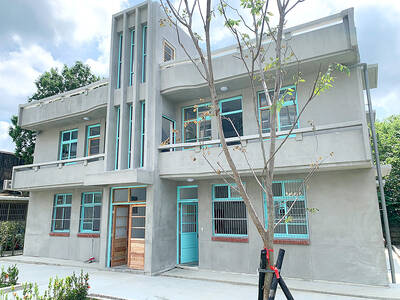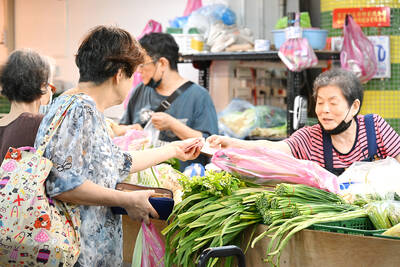Her desserts are often not at all sweet and she couldn’t give a fig if people complain that they don’t look great on Instagram.
But that did not stop Jessica Prealpato being named the best pastry chef on the planet Tuesday by the World’s 50 Best Restaurants ranking — the first woman ever to receive the honour.
The 32-year-old French woman, who is about to have her first child, is the creator of a whole new genre of guilt-free patisserie.

Photo: AFP
For Prealpato it is not about how a dessert looks, it’s how it tastes — and the feelgood glow afterwards.
The subtle and sublime creations she turns out at the three-star Michelin restaurant of the Plaza Athenee hotel in Paris are a rebuff to the sugar-rush burn of food porn.
Yet even she has not dared to have her father — a patissier forged in full-on sugar worship of French tradition — taste her creations that marry strawberries with pine and lemon with seaweed.
“He would not understand what I do at all,” she said.
Prealpato has eschewed the sugar high to go for what her boss, the French superchef Alain Ducasse, calls naturalit — or naturalness — bringing out the full range of flavours that an ingredient already has. What Prealpato also does is use ingredients that would never normally make it onto a dessert trolley.
So you have malted beer sorbet with barley crumble and hop galettes, cherry olive vinaigrette or vanilla Jerusalem artichokes with truffles.
SUGAR AS SEASONING
“We shake people up,” laughed Prealpato, the fourth French chef in a row to pick up the top prize.
She has already produced a book of 50 of her desserts called Desseralite, including her “All Rhubarb,” where the often astringent plant is served roasted, raw, fermented, grilled and poached.
“I love to use vinegars and try every style of cooking so that I get the most flavors out of a product,” said Prealpato, one of a tiny number of female patisserie chefs working in three-star restaurants.
Some of her peers have criticized her for the unfussy way she presents her food, claiming it is not sophisticated enough for such an upscale establishment. And four years ago, when she was starting out at the hotel, she said that Ducasse left her in tears when he refused to taste one of her first fruit-based desserts.
“I can see why now,” she said. “I had presented it like a patisserie chef usually would, with lots of mousse, cream and a tuile. For him, a dessert didn’t have to be about these things.”
So Prealpato “took everything away... today I rarely ever work with chocolate or coffee.”
Instead her desserts play with sourness and acidity, and she uses sugar as others would salt — for seasoning.
PRETTY ISN’T EVERYTHING
“I understand why some clients may not like that,” she said.
Initially hurt by such negative feedback, Prealpato has become used to it.
It also makes being crowned the world’s best pastry chef all the sweeter.
“I am amazed. It’s enormous for me. I never would have guessed that my patisseries would go that far.”
With a frankness rare at the top of her profession, Prealpato admitted that “they aren’t exactly beautiful to look at.”
“They may seem very simple but a huge amount of work goes into making them,” she said.
“Her cooking is absolutely of the moment,” said William Drew of the World’s 50 Best Restaurants. “The way she manipulates natural sugars without sacrificing flavor chimes perfectly with the cultural zeitgeist to cut down on sugar intake.”
On average it takes a month to create a new recipe and her dessert menu changes with the seasons. However, the Earth generally does not shake when Prealpato puts them on Instagram — unlike for her Parisian rival Cedric Grolet who won the title last year and has more than 1.3 million fans who eagerly share his visually stunning creations.
“My poor 20,000 followers!” the humble Prealpato joked.
Unlike Grolet — who like her is something of a sugar sceptic — she said she doesn’t have the time to make her desserts look good by putting them on a white background.
Nor does she have anything against traditional French patisseries, which she loves — she just doesn’t want to spend her life making them.
“I came here [to work with Ducasse] because I was sick of doing chocolate pistachio and cherry almond all the time. Some classics are so good I don’t see how you can revisit them,” she said.

June 2 to June 8 Taiwan’s woodcutters believe that if they see even one speck of red in their cooked rice, no matter how small, an accident is going to happen. Peng Chin-tian (彭錦田) swears that this has proven to be true at every stop during his decades-long career in the logging industry. Along with mining, timber harvesting was once considered the most dangerous profession in Taiwan. Not only were mishaps common during all stages of processing, it was difficult to transport the injured to get medical treatment. Many died during the arduous journey. Peng recounts some of his accidents in

“Why does Taiwan identity decline?”a group of researchers lead by University of Nevada political scientist Austin Wang (王宏恩) asked in a recent paper. After all, it is not difficult to explain the rise in Taiwanese identity after the early 1990s. But no model predicted its decline during the 2016-2018 period, they say. After testing various alternative explanations, Wang et al argue that the fall-off in Taiwanese identity during that period is related to voter hedging based on the performance of the Democratic Progressive Party (DPP). Since the DPP is perceived as the guardian of Taiwan identity, when it performs well,

A short walk beneath the dense Amazon canopy, the forest abruptly opens up. Fallen logs are rotting, the trees grow sparser and the temperature rises in places sunlight hits the ground. This is what 24 years of severe drought looks like in the world’s largest rainforest. But this patch of degraded forest, about the size of a soccer field, is a scientific experiment. Launched in 2000 by Brazilian and British scientists, Esecaflor — short for “Forest Drought Study Project” in Portuguese — set out to simulate a future in which the changing climate could deplete the Amazon of rainfall. It is

The Taiwan People’s Party (TPP) on May 18 held a rally in Taichung to mark the anniversary of President William Lai’s (賴清德) inauguration on May 20. The title of the rally could be loosely translated to “May 18 recall fraudulent goods” (518退貨ㄌㄨㄚˋ!). Unlike in English, where the terms are the same, “recall” (退貨) in this context refers to product recalls due to damaged, defective or fraudulent merchandise, not the political recalls (罷免) currently dominating the headlines. I attended the rally to determine if the impression was correct that the TPP under party Chairman Huang Kuo-Chang (黃國昌) had little of a